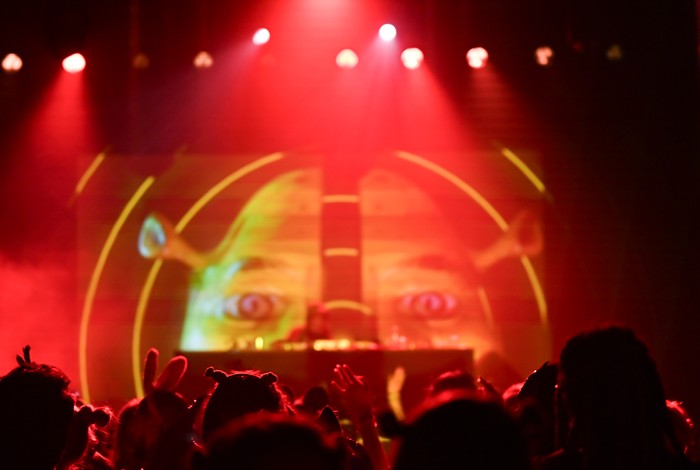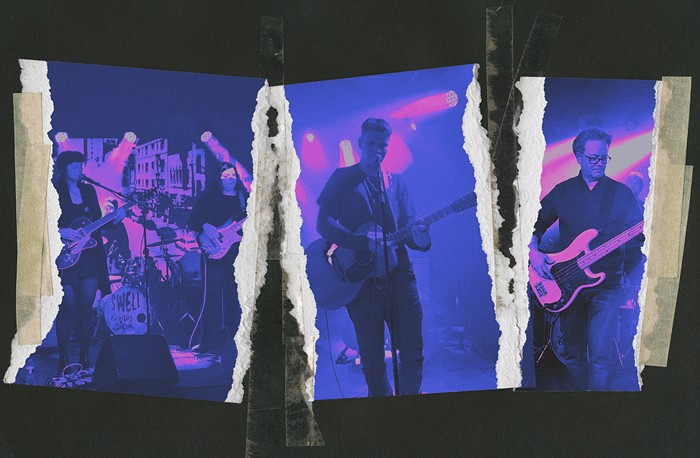EMP (all ages), 369-5483,
Fri March 30.
Let us imagine that somewhere, at this very moment, perhaps a lone dog (or a man: It makes no difference) is investigating its world. We may see our beast determining the absoluteness of the limits that bind its existence, turning up clues--a leash, a locked door, an empty water bowl--that only beg a more forbidding question. As the inquest grows more fervent, grand symbols of oppression start to close in like a dense, philosophical fog: the collar starts to feel like a manacle; the innocuous Purina logo takes on the aspect of a swastika. Everywhere, doors and ceilings loom too high, and hapless, rectilinear furniture clutters its path. Our beast might even cry out in mortal terror, though only to be greeted with an ominous silence and the sinking realization that it is hopelessly mired in a crippling obscurity.
Now, what, you might ask, does all of this have to do with the Residents? Well, naturally, all of this drama would require a soundtrack, and I would maintain that only the Residents could provide it. Their music, with its narcotic, occluded tones and operatic ambition, has always given voice to the voiceless, with a singular, hunchbacked grace that, for those who have paid attention, has only improved in the 29 years since they came upon the scene with their first EP, Santa Dog (an anagram of Satan God) in 1972.
Few have paid much attention to the Residents, however, because the Residents have always produced their work in a state of self-induced obscurity: Their publishing company bears the moniker "The Cryptic Corporation," and they once recorded an album with the stipulation that it be released only when the band had forgotten of its existence. Indeed, the band works under an avowed "theory of obscurity," which states that artists do their best work in utter seclusion from the need to please any audience whatsoever. The result is an at times astounding body of work, whose voice, inhuman, screeching, and cavernous, always seems to conjure up images of futile resistance in the face of an amorphous establishment.
Indeed, the brilliance of the Residents' musical art lies in locating an intense anxiety in a formless other, whose body cannot be located, and therefore whose soul cannot be laid to rest (to paraphrase Updike). The enigma of evil they face--it is not per se human, nor is it explicitly spiritual--is perfectly rendered in their music: Like the films of Guy Maddin, or Goya's last pictures, their art seems to lie in some fissure of common reality, whence it peers out with great trepidation at a messy and vindictive world. The strangled nasal voices and strange, synthesized loops and whistles--all layered under atonal guitar meanderings and eclectic, plodding rhythms--perfectly amplify an abiding sense of buried frustration. Whether addressing the victims of material greed on The Commercial Album, a failed uprising of mole people on The Mole Trilogy, or the freaks and ne'er-do-wells that coagulate around the midway in their brilliant CD-Roms Freak Show and Bad Day on the Midway, the Residents have always managed to imply a world whose boundaries are somehow both far beyond our own, yet innate to every cell of living human tissue.
All of which might make it seem that the Residents are surrealists, which they are not. To be sure, much of their visual iconography--the ever-present eyeballs, for example, or liquid flesh such as Jelly Jack, the Boneless Boy--are direct extrapolations of surrealist painting. But the Residents have always managed to expand their vision beyond the narcissistic constraints of surrealism. Their art is perhaps more akin to a sort of paranoid, repressed Dada, which, while not directly assaulting any specific establishment, nevertheless takes an energetic stance for revolution. Against what is irrelevant.
Of course, the Residents' art has, from the very beginning, been as much based in imagery as sound. Their great lost 1972 opus, the neo-expressionist film Vileness Fats, demonstrates an uncanny early ease with cinema. Likewise, their 1976 experimental short, The Third Reich and Roll, is considered by many to be one of the first music videos ever, and indeed is now housed in the permanent collection of the Museum of Modern Art. Moreover, their later CD-Rom work fulfills the promise of this early material. Working with such diverse talents as the brilliant computer animator Jim Ludke and designer Steve Cerio, the Residents managed to find the perfect mode of expression for their encompassing anxieties. The insatiable, vulgar vastness of the worlds conjured up by Freak Show and Bad Day on the Midway is squarely laid to rest by the Residents' prodigious paranoid imagination: the result is something akin to an experimental nonlinear opera. That their best work to date is contained in the virtual reality of a CD-Rom is somehow fitting for a group whose actual existence has never been less (or more) than implied.


















